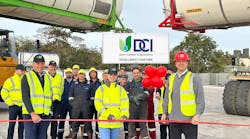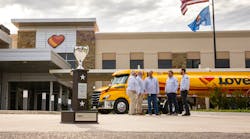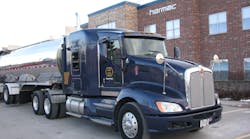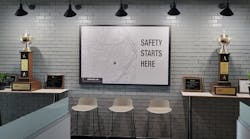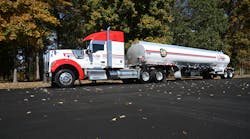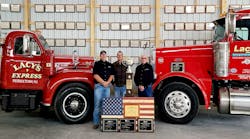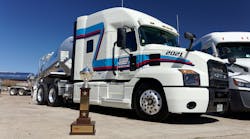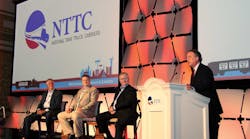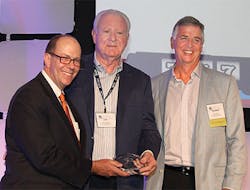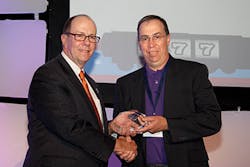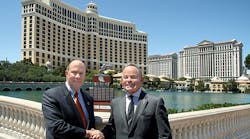“TECHNOLOGY can differentiate a company from the competition, but it must be the right fit. The challenge of choosing the best and right technology to meet the needs of tank truck operations was discussed during a C-level panel at the National Tank Truck Carriers’ 66th Annual Conference April 27-29 in Las Vegas, Nevada.
Headlined “Technology, Right Fit for Your Company” this was the inaugural panel of the Omnitracs-sponsored series that will address how tank fleets can best select the fleet management technology systems suited to their unique business and operational needs.
NTTC entered into an exclusive sponsorship agreement with Omnitracs LLC, a provider of fleet management solutions, to develop a panel discussion series at its annual events in 2014 and 2015.
Those events include the Annual Conference & Exhibits Show, the Annual Safety Meeting, the Summer Membership & Board of Directors Meeting, the Winter Membership & Board of Directors Meeting, and the seminar portion of Tank Truck Week.
The “Right Technology, Right Fit for Your Company” panel was moderated by NTTC president Daniel Furth and included panelists Chris Lofgren, president and chief executive officer of Schneider National Inc; Dennis Nash, founder, chairman and chief executive officer of The Kenan Advantage Group; and Greg Hodgen, president of Groendyke Transport Inc.
Q: Each of you brings a unique career path. Can you share your thoughts and philosophies on the application of technology in your operations?
Lofgren: I came up through technology with software development and hand-held communications, so that was my whole orientation and what brought me into the industry. Coming to work for Schneider, a company that was willing to put big bets on technology, I was trying to figure out how to differentiate the company but also how we could drive more efficiency and productivity for drivers. It’s always been in our DNA to say, ‘What’s the next thing we can do to help in those areas?’ We just got through a seven-year, $250 million investment to complete a technology platform extending from the driver all the way to the sales force. We’ve seen that essentially pay for itself already. It’s fundamental how we think about operating a business, fundamental in how we allocate capital every year. I think as more regulations come in and demands on our industry continue to escalate, it’s kind of become a minimum bar.
Hodgen: We come at technology from a couple of different angles. Technology delivers solutions. You can’t just pick technology and say, ‘This is a great tool,’ and put it into terminals and say, ‘This can make your life better.’ It’s kind of like this bottle of water. The label displays the beauty of a river running though a European village. The bottle is clear and the water looks good, but at some point, you say, ‘How does it taste? Will it do what it’s supposed to do and hydrate you?’ If we can’t sell our people on a tech product actually helping achieve some standard solution or if it’s not going to be something that’s easily understood by people at any level, they’re not going to adopt it.
Nash: I’ve always been very focused on the driver. Our position has always been, if something doesn’t add to the efficiency of the driver or create value to the customer, we’re really not interested. So the first 10 years at the company, I was very resistant to technology. We couldn’t see the value. We resisted until we saw technology get to the point where it made the job easier, increased productivity, and added to the customer. We’re finally seeing technology at the stage where we know there are great things. The next challenge will be to take that value and efficiency to the customer and actually have people on the ground to help them execute solutions with the technology.
Q: Where is technology germinating in your fleets? Is it bottom up? Or top down?
Lofgren: Most of the cost of that seven-year program wasn’t hardware and software. It was all work that had to be done to make sure processes were aligned and people’s roles were consistent and the system was understood all the way to the driver. There’s a saying out there that vision without execution is hallucination. There are a lot of great visions out there and a lot of great technology, but if you can’t get it into execution, there won’t be ROI (return on investment). In our business, those ideas come bottom up and get driven top down. Moving to electronic onboard recorders is top-down thing. Driven decisions, where we can change how drivers interact with our systems … they tend to come bottom up. I don’t think there’s one right answer.
Hodgen: I heard a great quote that a definition of innovation is adopting change before you’re forced to. Most of our businesses don’t have a lot of extra staff. My position is to look for areas crying out for help that need change, because sometimes you’re so busy executing and trying to take care of customers that you don’t see a different approach. How can we deliver solutions to somebody in the right position? We used to think one-size-fits-all. Now let’s test something at one location and see how it works. That helps us how deploy it.
Q: Let’s talk about electronic onboard recorders. All three of your companies are recognized as early adopters of the technology. Why jump into the pool first?
Nash: We started rolling out our technology in 2004. The concern I always had was, would there be enough value created? As we rolled out the system, our emphasis was more getting people prepared. We knew the drivers might be slow to accept it in some cases. Others were more ready to embrace it and take the next step. We primarily focused on getting folks used to using the equipment. It wasn’t so much the electronic logging devices. We were more centered on connecting to our back room, our scheduling, our customer. We had real-time information flowing and really started to get to a point where we weren’t touching paper as much.
Hodgen: We’ve been doing electronic driver logs for seven or eight years. Our first problem was, we wanted to know what kind of problems it was going to cause. Is this going to be something the workforce can handle, manage, and understand? Or are they going to say no one else is doing it and push back? I had phone calls, postcards. I had people come up to me and say, ‘I can’t believe you’re making us do this.’ But after we got over the initial hump, after they adopted it, they found their lives were better. It forced dispatchers to work more effectively. Prior to that, they said to the drivers, ‘You can do this, right?’ What’s the driver supposed to say? I’ve had drivers today tell me, ‘If you make me give this up (electronic logs), I’m going to quit.’
Lofgren: The other philosophy behind doing this is, there is no right way to do the wrong thing. Double logs are the wrong thing. They just are. I will tell you there were times when something went bad and we found out we weren’t as clean as we wanted to be. You don’t ever want to ask somebody to do something that puts them or somebody else in jeopardy. There was a productivity drop. We saw drivers quit. We had a good sized owner-operator fleet. We have a policy: If you are an owner-operator and want to drive for us, you’re putting it in. That’s non-negotiable for us.
Hodgen: Log violations are almost unheard of in our fleet today. We all know drivers can be creative, but they have to work pretty hard to have a log violation. The system is pretty straightforward and simple.
Lofgren: Once they do it, I think they will become advocates.
Q: Is it the best thing that’s happened to trucking this year?
Lofgren: Across the industry, drivers’ wages were falling short over last 20 years. Even if you go back 10 years, drivers’ wages didn’t keep up with inflation and the rest of the economy. In order to get drivers into trucks, they have to get paid. If someone is running an extra hour, it changes the fundamental cost basis. I think it’s going to let the industry run more safely and turn us into an industry that’s highly respected. It will fix a lot of bad actors who cause some of the tough situations to occur. The industry image is going to improve. I think it will be the single biggest thing to hit this industry since deregulation. It’ll be a blessing for us five or 10 years from now.
Nash: We’re focused on two areas. We saw an immediate improvement in safety performance—the accidents, preventables. I think obviously safety is the most important thing. It will improve the industry. I’m not just talking about EOBRs. There is a lot more to gain from onboard recorders. The other area I’m keying on is the professionalism of drivers. My dad was a truck driver, and he was proud to say he was a professional truck driver. I think this will do a lot of things to help recruitment. If they know they’re using technology to improve their performance, then we’re tying our product to that respect of professionalism. Using this technology and these onboard computers to help recruit professional drivers is great for our industry.
Q: Innovation has changed the dispatcher function and also potentially changed the most important relationship in our business: the dispatcher-driver relationship.
Nash: Analytics are critical in running your day-to-day business. Looking at trends and understanding drivers who might have a tendency to be involved in accidents. That’s challenging. Once you detect a problem like that, you can’t just sit on it. You have to do something. My biggest concern is how you execute that in the field. You expect the terminal manager to take that information and coach drivers. We can get the good drivers. We have great customers. We probably could do a better job of training middle-management people to execute and use the data that’s being provided.
Hodgen: Having onboard equipment does not create a relationship between you and the drivers. We have spent a lot of money working on the people side. If you use the information from your safety violations as a stick, then it will be a problem with drivers. We’ve learned if you sit down with drivers ahead of time and point out the good things they do and use it as a coaching opportunity, I would say 90% of the time that’s a positive experience and the driver says, ‘I had no idea it was that much.’ We think in our fleet, everybody has some bad habit. But we want you to be the best driver. You’re a professional. We want you to focus on this. It can be a very positive experience.
Lofgren: We used to have these debates. Do you use analytics to weed out the bottom 5% or 10% or build them to accelerate the performance of the 90%? You have to do both. You can’t afford to have bad actors in there. Of that bottom 10%, a good percentage want to figure out how to do the right thing. There are few people in the world who wake up every day and say, ‘I want to be a bad actor. I want to sluff off and be despicable.’ Having analytics where you can say, ‘Here’s a group that’s about ready to have a problem,’ that’s good. Nobody wants to have them. The ones who do want to get better will say, ‘Thank you.’ The other 2% at the bottom who don’t care would go somewhere else. We’re not going to be a place for them. You have to do both. In general, this is an opportunity to enhance everybody in the organization.
Q: Do you use technology as a competitive advantage against a company that doesn’t?
Nash: For me, it’s big differentiator for the customer. Just trying to make it easier for the customer to do business: automatic billing, auto pay, using that technology to make it easier for the customer is a huge differentiator. There is so much technology you can tie into the customer. He can come into your system and look for information. Just log onto your system. I think that is huge differentiator.
Lofgren: Here’s my view on competitive advantage. I was at Motorola right after the bag phone came out and they had just released the brick phone. We were working on a flip phone, and the technology to just reduce the size of those things. But when you look at how fast that changed … I think today I’m not sure you look at technology as a competitive advantage. I think it can be a competitive disadvantage. I was a technologist. I think the only sustainable advantage we have today in our companies is our people and our culture. Technology is merely there to take advantage of great people and great culture. ♦
Carrier executives recognized for 50 years of loyalty to NTTC

